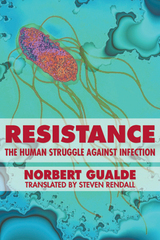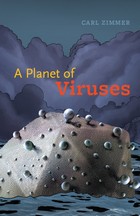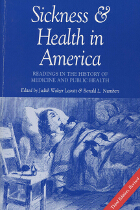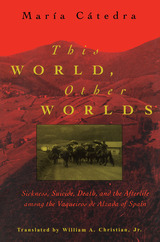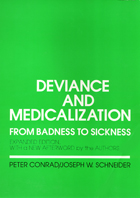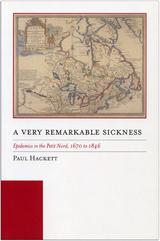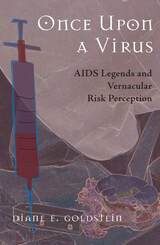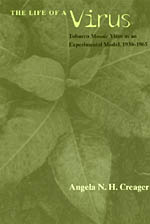SicknessCollection by Cassandra Verhaegen (9 items)Sick books. Includes the following tags:
AIDS (Disease), Cowboys, Death & Dying, Deviance, Deviant behavior, Epidemics, Evolution, Funeral rites and ceremonies, Health behavior, Horns, Legends, Life Sciences, Medical care, Mental illness, Microbiology, Newfoundland and Labrador, Once Upon, Other Worlds, Planet, Rabbits, Research & Methodology, Resistance, Social control, Social ethics, Traditional medicine, Viruses, Zimmer, Carl
See More
|
Resistance
by Norbert Gualde
translated by Steven Rendall Dana Press, 2006
A North Carolina woman dies of a flesh-eating bacterial disease. Thousands of people in West Africa are suffering from cholera. And antibiotics are rapidly becoming less and less effective at fighting what were once mild infections. The biggest threat to the future of human society may not be terrorist attacks or nuclear war, but rather microscopic bacteria. Immunologist Norbert Gualde explains in Resistance the dangers we face from bacterial resistance, asserting that we must confront the reality awaiting us--the next fatal plague may occur sooner than we think.
1
|
A Planet of Viruses
by Carl Zimmer
University of Chicago Press, 2011
For years, scientists have been warning us that a pandemic was all but inevitable. Now it's here, and the rest of us have a lot to learn.
2
|
Sickness and Health in America
edited by Judith W. Leavitt and Ronald L. Numbers
University of Wisconsin Press, 1997
An invaluable resource for students, scholars, and general readers, this highly regarded and widely used social history of medicine and public health in the United States is now available in a third edition. Extensively revised and updated, it includes twenty-one new essays; graphs illustrating the rise in deaths caused by HIV, homicide, and suicide; and a greatly expanded Guide to Further Reading. Entirely new sections on Sickness and Health, Early American Medicine, Therapeutics, the Art of Medicine, and Public Health and Personal Hygiene have been added, supplementing updated sections on the Science of Medicine, Education, the Allied Health Professions, Image and Income, Institutions, Race and Medicine, Epidemics, Public Health Reform, and Public Health and Medical Theory. An introductory essay and a series of historical photographs complement the articles.
See More
3
|
This World, Other Worlds
by María Cátedra
translated by William A. Christian, Jr. University of Chicago Press, 1992
The Vaqueiros de Alzada, a cattle-herding people in the Asturian mountains of Spain, have one of the highest suicide rates in Europe—and an attitude toward death that gives this statistic unusual meaning. This World, Other Worlds considers death among the Vaqueiros as a central cultural fact which reveals local ideas about the origin and destiny of humans, the relations of humans and animals, the configuration of the universe, and the nature of society. Interested chiefly in the conceptual and meaningful aspects of death, María Cátedra focuses on the cultural resources with which the Vaqueiros confront their own mortality—how they experience death and what this reveals about the way they see this world and other worlds. Applying sensitive ethnographic insight to a rich body of oral testimony, Cátedra discloses an unsuspected symbolic universe native to the Vaqueiros. Death is seen here in close, coherent relation to pain, age, and suffering; sickness and suicide, one must understand the cultural valuation of different ways of dying and the conditions under which suicides take place. To understand what it means to be a Vaqueiro is to understand how suicide can be perceived by a people as acceptable. A groundbreaking work in European ethnography, This World, Other Worlds takes symbolic analysis to a new level. In its illumination of local conceptions of death, grace, and sainthood, the book also makes a substantial contribution to the anthropology of religion.
4
|
Deviance and Medicalization
by Peter Conrad
Temple University Press, 1992
This classic text on the nature of deviance, originally published in 1980, is now reissued with a new Afterword by the authors. In this new edition of their award-winning book, Conrad and Schneider investigate the origins and contemporary consequences of the medicalization of deviance. They examine specific cases—madness, alcoholism, opiate addiction, homosexuality, delinquency, and child abuse—and draw out their theoretical and policy implications. In a new chapter, the authors address developments in the last decade—including AIDS, domestic violence, co-dependency, hyperactivity in children, and learning disabilities—and they discuss the fate of medicalization in the 1990s with the changes in medicine and continued restrictions on social services.
5
|
A Very Remarkable Sickness
by Paul Hackett
University of Manitoba Press, 2002
The area between the Great Lakes and Lake Winnipeg, bounded on the north by the Hudson Bay lowlands, is sometimes known as the "Petit Nord." Providing a link between the cities of eastern Canada and the western interior, the Petit Nord was a critical communication and transportation hub for the North American fur trade for over 200 years.Although new diseases had first arrived in the New World in the 16th century, by the end of the 17th century shorter transoceanic travel time meant that a far greater number of diseases survived the journey from Europe and were still able to infect new communities. These acute, directly transmitted infectious diseases – including smallpox, influenza, and measles – would be responsible for a monumental loss of life and would forever transform North American Aboriginal communities.Historical geographer Paul Hackett meticulously traces the diffusion of these diseases from Europe through central Canada to the West. Significant trading gatherings at Sault Ste. Marie, the trade carried throughout the Petit Nord by Hudson Bay Company ships, and the travel nexus at the Red River Settlement, all provided prime breeding ground for the introduction, incubation and transmission of acute disease. Hackettís analysis of evidence in fur-trade journals and oral history, combined with his study of the diffusion behaviour and characteristics of specific diseases, yields a comprehensive picture of where, when, and how the staggering impact of these epidemics was felt.
See More
6
|
Rabbits with Horns and Other Astounding Viruses
by Carl Zimmer
University of Chicago Press, 2011
Viruses are the smallest living things known to science, yet they hold the entire planet in their sway. Rabbits with Horns and Other Astounding Viruses explores the bizarre places viruses dwell, and considers the often unexpected ways they influence our world. From agricultural production and crystal caves to rabbits with horns and cervical cancer, viruses are behind many of the wonders—some fascinating, some frightening—of the natural world, as well as some of our greatest medical challenges. Through his engaging considerations of the tobacco mosaic virus, viruses in ocean algae, and the human papillomavirus, award-winning science writer Carl Zimmer brings us up to speed on the nuances and depth of today's cutting-edge scientific research on virology.
7
|
Once Upon A Virus
by Diane Goldstein
Utah State University Press, 2004
Once Upon a Virus explores how contemporary, or "urban," legends are indicators of culturally complex attitudes toward health and illness. Tracing the rich tradition of AIDS legends in relation to current scholarship on belief, Diane Goldstein shows how such stories not only articulate widespread perceptions of risk, health care, and health policy, they also influence official and scientific approaches to the disease and its management. Notions that appear in narratives of who gets AIDS, how and why, are indicators of broad issues involving health beliefs, concerns, and needs.
8
|
The Life of a Virus
by Angela N. H. Creager
University of Chicago Press, 2001
We normally think of viruses in terms of the devastating diseases they cause, from smallpox to AIDS. But in The Life of a Virus, Angela N. H. Creager introduces us to a plant virus that has taught us much of what we know about all viruses, including the lethal ones, and that also played a crucial role in the development of molecular biology. Focusing on the tobacco mosaic virus (TMV) research conducted in Nobel laureate Wendell Stanley's lab, Creager argues that TMV served as a model system for virology and molecular biology, much as the fruit fly and laboratory mouse have for genetics and cancer research. She examines how the experimental techniques and instruments Stanley and his colleagues developed for studying TMV were generalized not just to other labs working on TMV, but also to research on other diseases such as poliomyelitis and influenza and to studies of genes and cell organelles. The great success of research on TMV also helped justify increased spending on biomedical research in the postwar years (partly through the National Foundation for Infantile Paralysis's March of Dimes)—a funding priority that has continued to this day.
9
|
| Click here to go to the beginning. | |||||||||
